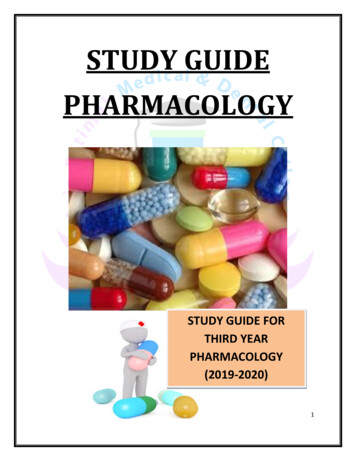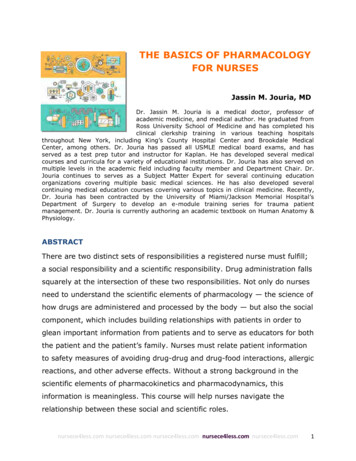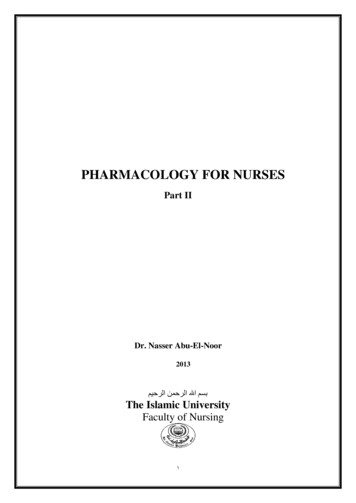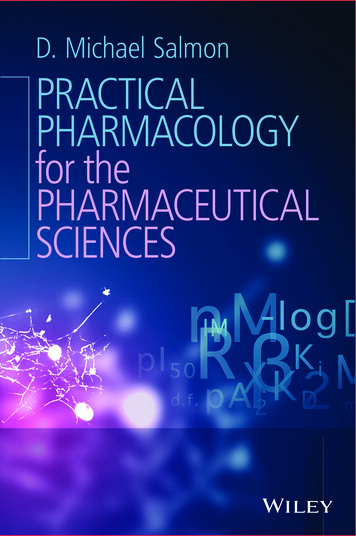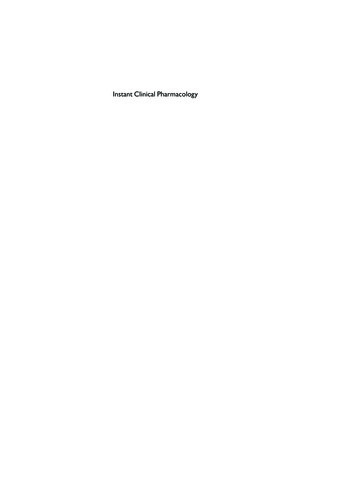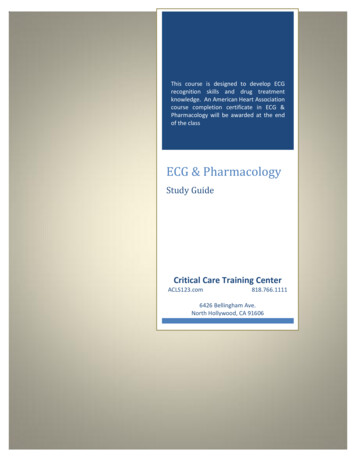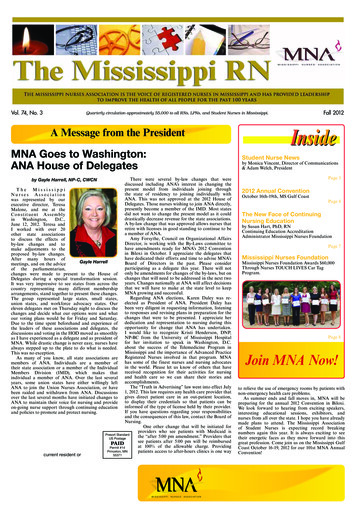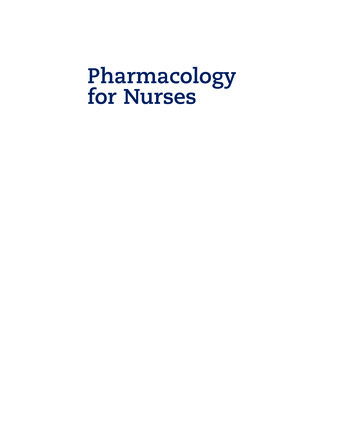
Transcription
Pharmacologyfor NursesA01 ADAM8334 06 SE FM.indd 118/01/2019 22:38
A01 ADAM8334 06 SE FM.indd 218/01/2019 22:38
Sixth EditionPharmacologyfor NursesA Pathophysiologic ApproachMichael Patrick AdamsAdjunct Professor of Anatomy and PhysiologyHillsborough Community CollegeFormerly Dean of Health ProfessionsPasco-Hernando State CollegeLeland Norman Holland, Jr.ProfessorHillsborough Community CollegePolk State CollegeCarol Quam UrbanAssociate Dean for Practice and Strategic InitiativesAssociate ProfessorCollege of Health and Human ServicesGeorge Mason UniversityA01 ADAM8334 06 SE FM.indd 318/01/2019 22:38
Executive Portfolio Manager: Pamela FullerDevelopment Editor: Teri ZakPortfolio Management Assistant: Taylor ScuglikVice President, Content Production and Digital Studio:Paul DeLucaManaging Producer Health Science: Melissa BasheContent Producer: Michael GiacobbeVice President, Sales & Marketing: David GesellVice President, Director of Marketing: Brad ParkinsExecutive Field Marketing Manager: Christopher BarryField Marketing Manager: Brittany HammondDirector, Digital Studio: Amy PeltierDigital Producer: Jeff HennFull-Service Vendor: Pearson CSCFull-Service Project Management: Pearson CSC, Dan KnottManufacturing Buyer: Maura Zaldivar-Garcia, LSCCommunications, Inc.Cover Designer: Pearson CSCText Printer/Bindery: LSC Communications, Inc.Cover Printer: Phoenix ColorCredits and acknowledgments for content borrowed from other sources and reproduced, with permission, in thistextbook appear on appropriate page within text except for the following:Unit 1 opener, dimdimich/FotoliaUnit 2 opener, Lighthunter/ShutterstockUnit 3 opener, nerthuz/FotoliaUnit 4 opener, nerthuz/FotoliaUnit 5 opener, Sebastian Kaulitzki/FotoliaUnit 6 opener, nerthuz/FotoliaUnit 7 opener, nerthuz/FotoliaUnit 8 opener, nerthuz/FotoliaUnit 9 opener, dimdimich/FotoliaCover, Pearson EducationDrug icon used throughout, tassel78/123RF.Copyright 2020, 2017, 2014, 2011, and 2008 by Pearson Education, Inc., or its affiliates. 221 River Street,Hoboken, NJ 07030. All Rights Reserved. Printed in the United States of America. This publication is protected bycopyright, and permission should be obtained from the publisher prior to any prohibited reproduction, storagein a retrieval system, or transmission in any form or by any means, electronic, mechanical, photocopying, recording, or otherwise. For information regarding permissions, request forms and the appropriate contacts within thePearson Education Global Rights & Permissions Department, please visit www.pearsoned.com/permissions/Unless otherwise indicated herein, any third-party trademarks that may appear in this work are the property oftheir respective owners and any references to third-party trademarks, logos or other trade dress are for demonstrative or descriptive purposes only. Such references are not intended to imply any sponsorship, endorsement,authorization, or promotion of Pearson’s products by the owners of such marks, or any relationship between theowner and Pearson Education, Inc. or its affiliates, authors, licensees, or distributors.Notice: Care has been taken to confirm the accuracy of information presented in this book. The authors, editors,and the publisher, however, cannot accept any responsibility for errors or omissions or for consequences fromapplication of the information in this book and make no warranty, express or implied, with respect to its contents.The authors and publisher have exerted every effort to ensure that drug selections and dosages set forth in thistext are in accord with current recommendations and practice at the time of publication. However, in view ofongoing research, changes in government regulations, and the constant flow of information relating to drug therapy and drug reactions, the reader is urged to check the package inserts of all drugs for any change in indicationsof dosage and for added warnings and precautions. This is particularly important when the recommended agentis a new or infrequently employed drug.Library of Congress Cataloging-in-Publication DataNames: Adams, Michael, 1951- , author. Holland, Leland Norman, 1957- ,author. Urban, Carol Q. (Carol Quam), author.Title: Pharmacology for nurses : a pathophysiologic approach / MichaelPatrick Adams, Leland Norman Holland, Jr., Carol Quam Urban.Description: Sixth edition. Hoboken, N.J. : Pearson, [2020] Includesbibliographical references and index.Identifiers: LCCN 2019000512 ISBN 9780135218334 ISBN 0135218330Subjects: MESH: Drug Therapy Pharmacological Phenomena Pharmacology Nurses InstructionClassification: LCC RM301 NLM WB 330 DDC 615/.1--dc23 LC record available at https://lccn.loc.gov/2019000512ISBN-10: 0-13-521833-01 20ISBN-13: 978-0-13-521833-4A01 ADAM8334 06 SE FM.indd 418/01/2019 22:38
About the AuthorsMICHAEL PATRICK ADAMS, PHD, is an accomplished ed-ucator, author, and national speaker. The National Institutefor Staff and Organizational Development in Austin, Texas,named Dr. Adams a Master Teacher. He has published twoother textbooks with Pearson Publishing: Core Concepts inPharmacology and Pharmacology: Connections to Nursing Practice.Dr. Adams obtained his master’s degree in pharmacology from Michigan State University and his doctorate ineducation from the University of South Florida. Dr. AdamsLELAND NORMAN HOLLAND, JR., PHD (NORM), over25 years ago, started out like many scientists, planning fora career in basic science research. He was quickly drawn tothe field of teaching in higher medical education, where hehas spent most of his career. Among the areas where he hasbeen particularly effective are preparatory programs innursing, medicine, dentistry, pharmacy, and allied health.Dr. Holland is both a professor and supporter in nursingeducation nationwide. He brings to the profession a depthof knowledge in biology, chemistry, and medically relatedCAROL QUAM URBAN, PHD, RN, Associate Professor, isthe Associate Dean for Practice and Strategic Initiatives inthe College of Health and Human Services at George MasonUniversity in Fairfax, Virginia. Teaching in the School ofNursing for over 25 years, and most recently in the positionof Director of the School, she considers pharmacology to bea course that truly integrates nursing knowledge, skills, andwas on the faculty of Lansing Community College andSt. Petersburg College, and served as Dean of Health Professions at Pasco-Hernando State College for 15 years. Heis currently Adjunct Professor of Biological Sciences atHillsborough Community College.I dedicate this book to nursing educators, who contribute everyday to making the world a better and more caring place.—MPAsubjects, such as microbiology, biological chemistry, andpharmacology. Dr. Holland’s doctoral degree is in medicalpharmacology. He is very much dedicated to the success ofstudents and their preparation for careers in health care.He continues to motivate students in the lifelong pursuitof learning.To the greatest family in the world: Karen, Alexandria, Caleb,and Joshua.—LNHIIinterdisciplinary teamwork. She has co-authored thePearson textbook Pharmacology: Connections to NursingPractice with Dr. Adams.To my daughter, Joy, an extraordinary pediatric hematology-oncologynurse, and in memory of my son, Keith, and husband, Michael.—CQUvA01 ADAM8334 06 SE FM.indd 518/01/2019 22:38
Thank YouOur heartfelt thanks go out to our colleagues fromschools of nursing across the country who have giventheir time generously to help create this exciting new edition. These individuals helped us plan and shape ourbook and resources by reviewing chapters, art, design,and more. Pharmacology for Nurses: A PathophysiologicBeatrice Adams, PharmDCritical Care Clinical PharmacistTampa General HospitalDepartment of PharmacyTampa, FloridaShannon Allen, CRNA, MSNAProfessorNew Mexico Junior CollegeHobbs, New MexicoCandyce Antley, RN, MNInstructorMidlands Technical CollegeColumbia, South CarolinaCuleta Armstrong, MSN, RNClinical Assistant ProfessorUniversity of MemphisMemphis, TennesseeWanda Barlow, MSN, RN,FNP-BCInstructorWinston-Salem State UniversityWinston-Salem, North CarolinaSophia Beydoun, RN, BSN, MSN,AA-ANDProfessorHenry Ford Community CollegeDearborn, MichiganApproach, sixth edition, has reaped the benefit of your collective knowledge and experience as nurses and teachers,and we have improved the materials due to your efforts,suggestions, objections, endorsements, and inspiration.Among those who gave their time generously are thefollowing:Marcus W. Campbell, PharmD,BC-ADMAssistant Professor Pharmacy PracticeDirector, Center for Drug Information& ResearchLECOM School of PharmacyBradenton, FloridaRachel Choudhury, MSN, MS, RN, CNEAssociate Dean and Program Director,ABSNMusco School of Nursing and HealthProfessionsBrandman UniversityIrvine, CaliforniaDarlene Clark, MS, RNSenior Lecturer in NursingPennsylvania State UniversityUniversity Park, PennsylvaniaJanice DiFalco, RN, MSN, CNS,CMSRN, FAACVPRProfessorSan Jacinto CollegePasadena, TexasDeepali Dixit, PharmD, BCPSClinical Assistant ProfessorRutgers UniversityPiscataway, New JerseyStaci Boruff, PhD, RNAssistant Academic Dean of HealthProgramsProfessor of NursingWalters State Community CollegeMorristown, TennesseeRachael Durie, PharmD, BCPSCardiology Clinical PharmacistAssistant Professor of ClinicalPharmacyRutgers UniversityNeptune, New JerseyBridget Bradley, PharmD, BCPPAssistant ProfessorPacific UniversityHillsboro, OregonDeborah Dye, RN, MSNAssistant Professor/NursingDepartment ChairIvy Tech Community CollegeLafayette, IndianaMary M. Bridgeman, PharmD,BCPS, CGPClinical Assistant ProfessorRutgers UniversityPiscataway, New JerseyReamer L. Bushardt, PharmD,P.A.-CProfessorWake Forest Baptist HealthWinston-Salem, North CarolinaAdina C. Hirsch, PharmD, BCNSPAssistant Professor of PharmacyPracticePhiladelphia College of OsteopathicMedicinePhiladelphia, PennsylvaniaLinda Howe, PhD, RN, CNS, CNEAssociate ProfessorUniversity of Central FloridaOrlando, FloridaAnne L. Hume, PharmD, FCCP,BCPSProfessor of PharmacyUniversity of Rhode IslandKingston, Rhode IslandRagan Johnson, DNP, APRN-BCAssistant ProfessorUniversity of TennesseeMemphis, TennesseeVinh Kieu, PharmDAssistant ProfessorGeorge Mason UniversityFairfax, VirginiaDorothy Lee, PhD, RN, ANP-BCAssociate Professor of NursingSaginaw Valley State UniversityUniversity Center, MichiganToby Ann Nishikawa, MSN, RNAssistant ProfessorWeber State UniversityOgden, UtahDr. Diana Rangaves, PharmD, RPhDirector, Pharmacy TechnologyProgramSanta Rosa Junior CollegeSanta Rosa, CaliforniaJacqueline Frock, RN, MSNProfessor of NursingOklahoma City Community CollegeOklahoma City, OklahomaTimothy Reilly, PharmD, BCPS,CGP, FASCPClinical Assistant ProfessorRutgers UniversityPiscataway, New JerseyJasmine D. Gonzalvo, PharmD,BCPS, BC-ADM, CDEClinical Associate ProfessorPurdue UniversityWest Lafayette, IndianaJanet Czermak Russell, MS, MA,APN-BCAssociate ProfessorEssex County CollegeNewark, New JerseyviA01 ADAM8334 06 SE FM.indd 618/01/2019 22:38
Pooja Shah, PharmDClinical Assistant ProfessorRutgers UniversityPiscataway, New JerseyDustin Spencer, DNP, NP-C, ENP-BCAssistant Professor of NursingSaginaw Valley State UniversityUniversity Center, MichiganSuzanne Tang, MSN, APRN, FNP-BCInstructorRio Hondo CollegeWhittier, CaliforniaSamantha Smeltzer, RNProfessor of NursingMount Aloysius CollegeCresson, PennsylvaniaDr. Jacqueline Stewart, DNP, CEN,CCRNAssociate Professor of NursingWilkes UniversityWilkes-Barre, PennsylvaniaRyan Wargo, PharmD, BCACPAssistant Professor of PharmacyPracticeDirector of AdmissionsLECOM School of PharmacyBradenton, FloridaRose Marie Smith, RN, MS, CNEDivision Dean of Nursing, LiberalArts, Social and BehavioralSciencesRedlands Community CollegeEl Reno, OklahomaRebecca E. Sutter, DNP, APRN,FNP-BCAssociate ProfessorGeorge Mason UniversityFairfax, VirginiaTimothy Voytilla, MSN, ARNPNursing Program DirectorKeiser UniversityTampa, FloridaviiA01 ADAM8334 06 SE FM.indd 718/01/2019 22:38
PrefaceWhen students are asked which subject in their nursingprogram is the most challenging, pharmacology alwaysappears near the top of the list. The study of pharmacologydemands that students apply knowledge from a wide variety of the natural and applied sciences. Successfully predicting drug action requires a thorough knowledge ofanatomy, physiology, chemistry, and pathology as well asthe social sciences of psychology and sociology. Lack ofadequate pharmacology knowledge can result in immediate and direct harm to the patient; thus, the stakes in learning the subject are high.Pharmacology cannot be made easy, but it can bemade understandable when the proper connections aremade to knowledge learned in these other disciplines. Thevast majority of drugs in clinical practice are prescribed forspecific diseases, yet many pharmacology textbooks fail torecognize the complex interrelationships between pharmacology and pathophysiology. When drugs are learned inisolation from their associated diseases or conditions, students have difficulty connecting pharmacotherapy to therapeutic goals and patient wellness. The pathophysiologyfocus of this textbook gives the student a clearer picture ofthe importance of pharmacology to disease and, ultimately, to patient care. The approach and rationale of thistextbook focus on a holistic perspective to patient carewhich clearly shows the benefits and limitations of pharmacotherapy in curing or preventing illness. In addition toits pathophysiology focus, medication safety and interdisciplinary teamwork are consistently emphasized throughout the text. Although difficult and challenging, the studyof pharmacology is truly a fascinating, lifelong journey.New to This EditionThe sixth edition of Pharmacology for Nurses: A Pathophysiologic Approach has been thoroughly updated to reflectcurrent pharmacotherapeutics and advances in understanding disease. NEW! Applying Research to Nursing Practice featureillustrates how current medical research is used to improve patient teaching. Books, journals, or websitesmay be cited, and the complete source informationprovided in the References section at the end ofthe chapter. NEW! Key terms are listed at the beginning of eachchapter along with corresponding page numbers thatindicate where their definitions may be found withinthe chapter. UPDATED! Check Your Understanding questionsappear throughout the drug chapters to reinforcestudent knowledge. EXPANDED! Includes more than 40 new drugs, drugclasses, indications, and therapies that have been approved since the last edition. UPDATED! Black Box Warnings issued by the FDA areincluded for all appropriate drug prototypes. UPDATED! Pharmacotherapy Illustrated diagramshelp students visualize the connection between pharmacology and the patient. UPDATED! Nursing Practice Application charts havebeen revised to contain current applications to clinicalpractice with key lifespan, safety, collaboration, and diversity considerations noted.Organization and Structure—A BodySystem and Disease ApproachPharmacology for Nurses: A Pathophysiologic Approach is organized according to body systems (units) and diseases(chapters). Each chapter provides the complete informationon the drug classifications used to treat the diseases. Specially designed numbered headings describe key conceptsand cue students to each drug classification discussion.The pathophysiologic approach clearly places thedrugs in context with how they are used therapeutically.The student is able to locate easily all relevant anatomy,physiology, pathology, and pharmacology in the samechapter in which the drugs are discussed. This approachprovides the student with a clear view of the connectionamong pharmacology, pathophysiology, and the nursingcare learned in other clinical courses.The vast number of drugs available in clinical practiceis staggering. To facilitate learning, this text uses drug prototypes in which the most representative drugs in eachclassification are introduced in detail. Students are less intimidated when they can focus their learning on one representative drug in each class.viiiA01 ADAM8334 06 SE FM.indd 818/01/2019 22:38
PrefaceChapter 15 Drugs for Seizuresix179This text uses several strategies toPrototype DrugValproic Acid (Depakene, others)connect pharmacology to nursing practice.Therapeutic Class: Antiseizure drugPharmacologic Class: ValproateThroughout the text the student will findPHARMACOKINETICS (PO CAPSULES)Actions and Uses15 Drugs for Seizures175Valproic acid has become a preferred drug for treating manyChapter OnsetPeakDurationinteresting features, such as Complementypes of epilepsy. This medication has several trade names and2–4 days1–4 h6–24 hformulations, which can cause confusion when studying it.tary and Alternative Therapies, Treating Valproic acid (Depakene) is the standard form of the drugAdverse Effectsthe Diverse Patient, Community-Orientedgiven PO.Prototype DrugPhenobarbital(Luminal)Side effects include sedation, drowsiness, GI upset, and pro Valproate sodium (Depacon) is the sodium salt of valproiclonged bleeding time. Other effects include visual disturbances,Practice, and LifespanConsiderations,TherapeuticClass: Antiseizure drug; sedativePharmacologicagonistacid given PO or IV. Class: Barbiturate; GABAA receptormuscleweakness, tremor, psychomotor agitation, bone Divalproex sodium (Depakote ER) is a sustained releasemarrow suppression, weight gain, abdominal cramps, rash,that clearly place the drugs in context withcombination of valproic acid and its sodium salt in aalopecia,pruritus,photosensitivity, erythema multiforme, andActions and UsesWith overdose, phenobarbital may causesevererespiratory1:1 mixture. It is given PO and is available in an enterictheir clinical applications.Re- used for the managefatal hepatotoxicity.Black Box Warning: May result in fatalPhenobarbital is a Applyinglong-acting barbituratedepression, CNS depression, coma, anddeath.coated form.hepatic failure, especially in children under the age of 2 years.mentPracticeof a variety offeaturesseizures. It isillusalso used to produce sedasearch to NursingAll three msoften precede hepatotoxicity: weakness,Contraindications: Administration of phenobarbital is inadvistion. Phenobarbital should not be used for pain reliefcalbecausevalproate itafter absorption or on entering the brain. Thefacial edema, anorexia, and vomiting. Liver function tests severeuncontrate how currentmaymedicalresearchisusedpharmacokinetics of each form varies, and doses are notbe performed prior to treatment and at specific intervals durincrease a patient’s sensitivity to pain.trolled pain, preexisting CNS depression,porphyrias,severeing thefirst 6 monthsof treatment. Valproic acid can producePhenobarbital actsbiochemicallyby enhancing interchangeable.the action of In this text, the name valproic acid is usedto improve patientteaching.PatientSafety170 Unit3 The Nervous Systemto describe all forms ofrespiratorythe drug, unlessspecificallystateddisease with dyspnea or sand teratogenic effects, includingthe GABA neurotransmitter, which is responsible for suppressingotherwise.spinabifida.illustrates potentialpitfalls that can leador prostatic hypertrophy.abnormal neuronal discharges that can cause epilepsy. Valproic acid is administered as monotherapy or in combiContraindications:Hypersensitivity may occur. Thisneededsafety precautions.In collaborationpoisoning—andchangesin perfusion—suchaswiththosenationother AEDsimplementingto treat absence seizuresand complexto medication errors.PharmFactscontainmedication should not be administered to patients with liverInteractionspartial seizures.ER isthealsopatient,approved forthe healthcareprevenwiththeprovider, pharmacist, andcaused by hypotension, stroke, shock, and cardiacdys-Depakotedisease, bleeding dysfunction, pancreatitis, and congenitalAdministrationstatistics and factsthat are Alertsrelevantto thetion of migraine headachesand maniaassociatedwith bipolarDrug–Drug:Phenobarbitalinteractswithmany other drugs.nurseare instrumentalin achievingrhythmias—maybe causes.metabolicpositivedisorders. therapeuticOff-label indicationsincludebehavioraldistur Parenteralphenobarbital is a ouldnotseverebetakenwithalcoholor other ,chapter. Check YourUnderstandingfeabances,such as agitation due to dementia, Alzheimer’s lar (IM) injections may produce a local inflammatoryreacbecausethese eractionspatient–familysupport,and education,seizureor explosive temper in patientswith ADHD; persistenthiccups;with studentsepilepsy.BecauseseveralAEDseffectivetures encourageto applywhatDrug–Drug: depressionValproic acid interactswith many drugs. Fortion. IV administrationis rarelyuseddecreasebecause theextravasationtheriskachievedof life-threateningrespiratoryorand status epilepticus increasingrefractoryIVdiazepam.controltocanbein a majorityof patients.example, aspirin, cimetidine, chlorpromazine, erythromycin, andness of mayhormonalcontraceptives,producetissuenecrosis. additional barrier methcardiac arrest. Phenobarbital increasesthe metabolism of manythey have alreadyreadin thechapter.felbamate may increase valproic acid toxicity. Concomitant warAdministration Alertsods of birth control should be used to avoid unintendeddrugs, (GI)reducingtheir effectiveness. Controlled substance: Schedule IV.farin, aspirin, or alcohol use can cause severe bleeding. Alcohol, Valproic acid is a othergastrointestinalirritant. AdviseStudents learnbettersuppliedpregnancy.Prior whento pregnancyand considering es, and other CNS depressants potentiate CNSnottochewextended-releasetabletsbecause Pregnancy category s andof seizures,patients shouldconsult with theirmouthhealthdepressant action. Use of clonazepam concurrently with valsoreness will occur.with accurate, natureattractivegraphicsand richThe differingpresentation of seizuresrelates to their signsincreaseserumphosphatase.proic acid may induce absence seizures. Valproic acid increases Donot mixcare provider to determine the most appropriateplanofvalproic acid syrup with carbonated beveragesandsymptoms.Symptomsmay rangefrom sudden,violentserum phenobarbitaland phenytoinlevels. Lamotrigine, pheit will triggerimmediaterelease ofthe drug, whichmedia resources.Pharmacologyfor Nurses:Aactionfor seizure control.When al/Food:Kava,chamomilepotentiatenytoin, andmayrifampinlower valproicacid levels.shakingandtotal valerian,loss of andconsciousnessto muscletwitchcauses severe mouthand throatirritation.is necessarybecausemanyare pregnancyD. Pathophysiologic AOnsetpproachcontainsa genersedation. Open capsules andsprinkleonsoftfoodsifthepatientPeak AEDsDuration categorying or slight tremor of a limb. Staringspace, alteredLab Tests: intoUnknown.AEDs such as lamotrigine, gabapentin, and zonisamidecannot swallow them.20–60 minwith an4–12 uhnequaledPO; 30 min IV 10–16 h PO; 4–10 h IVvision, andareother treatmentbehaviorsous number gThere is nospecificfora personHerbal/Food:Unknown. havealowerriskPO; 5 min IVmay exhibit.Determiningcause of recurrentseizuresoverdose.Drug removalmay betheaccomplishedby gastric lavageof teratogenicity. Some AEDsmay cause folate deficiency,art program. Pharmacotherapy Illustratedis useessentialfor properdiagnosisandmayselectionof theorofactivatedcharcoal.Hemodialysisbeeffectivein mostcondition correlated with fetal neural tube defects. Vitafeatures appearaminthroughouteffective removaltreatmentoptions. from the body. Treatment isAdverse Effects the text, breakfacilitatingofphenobarbitalsupplements may be necessary. Eclampsia is a severeMethodsof classifyingepilepsyhavechangedPhenobarbitalis aintoScheduleIV drugunthat may cause depensupportiveand consistsmainly of endotrachealintubationand oversuch as lamotrigine(Lamictal)and zonisamide (Zonegran),ing down esto worsenpreg- Seizures15.8 asTreatingtime. For example,terms tigatedtheir roles in treating absence seidence. Common side effects include drowsiness, vitamin defimechanicalventilation.theTreatmentof eizures,coma,andwithSuccinimidesderstood enhave,forbethemost part, been replaced by more descriptive found to be effective inciencies (vitamin D; folate 3B9 4; and B12), and laryngospasms.sionmaynecessary.perinatalmortality. Eclampsia is likely to occurSuccinimidesfrom aroundpatients with partial seizures, usually in combination withare medicationsthat suppressby areand detailedlabels.seizuresEpilepsiestypically identified usingmechanisms showthestudentstep-by-stepother antiseizure medications.the 20th week of gestation until at least 1 weekdelayingafter deliverycalcium influx into neurons. By raising the seitheInternationalClassificationofEpileptic Seizures nomenzure eclampsiathreshold, succinimides keep neurons from firing tooofthebaby.Approximately25%ofwomenwithhow drugs act.clature.Theseare aretermedpartial (focal), generalized, andquickly, thus suppressingabnormalfoci. Theygenerallyexperience seizures within 72 hours postpartum.For years,only effective against absenceThesyndromessuccinimides (Table 15.1). Types of partialspecialseizures.epilepticone of the approaches used to prevent or treateclampticare listedin Table 15.5.(focal) seizures or generalized seizures may be recognizedEthosuximideCheck Your Understanding 15.1seizures was magnesium sulfate. The mechanismfor this (Zarontin) is the most commonly prebasedon symptomsobservedduring a seizure episode.scribed drug inAthis class.It remainsa preferred choiceforIf an antiseizure drug must be discontinued, how will this be accomComplementaryand ty is notwell ecificnatureofabsence seizures, although valproic acid is also effective forplished, andis this methodnecessary?See Appendix A for theprototypefeatureforFORmagnesiumpresentedinTHE KETOGENICDIETEPILEPSY sulfate is thesetypes of seizures. Someof the ersare morecomplex.Chapter 43.The Seizuresketogenic candiet haveis mostoften used whenseizurescannotbehas a ketogenic ratio of 3 or 4 g of fat to 1 g of protein and carbohya significantimpacton thequalitycontrolledthroughor whenif thereunacceptdratede LimaConceptset al., 2017). Becauseof the high ratio of fatoflife. Theymaypharmacotherapycause serious injurythey areoccurwhile15.3(AzevedoGeneralof Antiseizureadverseeffects toathemedications.Before antiseizuredrugsin the diet, complications such as hyperlipidemia and hepatotoxicaablepersonis drivingvehicleor performinga dangerousPharmacotherapywere developed,diet wasprimarytreatmentepilepsy.itymay occur, and patients on this diet need to be monitored longM15 ADAM8334 06 SE C15.indd17908/12/2018activity.Almost thisall stateswilla notgrant,or will fortakeaway,studieshave andexaminedthe possibilitythat vedo de Limaet al.,patient2017;The tochoiceAEDadverseis highlyindividualizefor eachaRecentdriver’slicenserequirea seizure-freebeforecould providebenefit forpatientsWithoutwith Alzheimer’s,Parkinson’s,andArslanet al., 2016,).and dependson the type of seizures, the patient’s previgrantinga driver’slicense.successfulpharmacoother Singh,&suggests EEGthat thedietandproducesa high pathologies.success rateous Researchmedical history,data,associatedtherapy,epilepsy can severelyparticipationschool,Joginapally, 2016;Veyrat-Durebexet al.,2018).exact mechacomparedto standardistreatment,withpatientbetter controlof seizures.Once a medicationselected, theis placedon a lowemployment,andsocial activitiesandcan Thedefinitelyaffectnism behind theChroniceffectivenessof the dietmayis unknownand appearstoImprovementnoted rapidlyand the dietappearsuntilto be seizureequallyinitial dose.mayThebeamountis oorlyinclude both directeffect fromketone bodyincreases, and tlyreportedadversecontrol foris dseizures.Importantconsiderationsin nurschangesoccur, identifyingincreasing GABAand rrhea,andobtainedhunger.tional includeincreasesin dose.Serumdrug levelsmay beingcarethatincludepatientsat risk neurotransmitfor seizures,ters (Rho, 2017).the pattern and type of seizure activity, andCostand theof followingthe dietlong term may thealsomostlimitto assistthedifficultyhealthcareproviderin determiningdocumentingThe ketogenic diet is a stringently calculated diet that is highin fat and low in carbohydrates and protein. It limits water intake toavoid ketone dilution and carefully controls caloric intake. Each meal14:27its use (Wijnen et al., 2017). Those interested in trying the diet mustconsult with their healthcare provider to optimize the therapy. Thelong-term effects are not yet fully known.Treating the Diverse Patient: Sports-Related ConcussionsThere is increased awareness and concern about sports-relatedconcussions at all ages. Concussions are a form of traumaticbrain injury (TBI) and can range from mild to severe, with immediate and long-term consequences, including dementia
Nursing for over 25 years, and most recently in the position of Director of the School, she considers pharmacology to be a course that truly integrates nursing knowledge, skills, and interdisciplinary teamwork. She has co-authored the Pearson textbook Pharmacology: Connect
